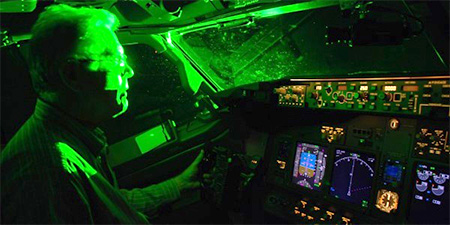The incidence of flight crew being targeted by the menacing green (or blue) light is on the increase. There’s not a lot you can do to prevent them, there’s a bit you can do to mitigate their effects, but the most important thing is to report them.

The number of reported laser strikes against aircraft has been growing since 2014.
In that year, rising stats briefly dipped when tough new rules covering the import, supply, and possession of high- power laser pointers came into effect.
Now included under the Summary Offences Act 1981, just possessing a high power (an output of more than one milliwatt) laser in public, without a reasonable excuse, can land someone in jail for up to three months or with a fine of up to $2000.
Since 2014, however, there’s been a 55 per cent increase in reported laser strikes, with 2017 the most laser-struck year on record – 161 reported occurrences.
CAA Air Transport Inspector, Pete Wilson, has more than 6000 hours flying in Europe, including as a British Airways CityFlyer captain.
He’s been lasered more than 30 times – on one occasion, twice in a few moments, from one direction, and then from the completely opposite direction.
“But the worst was on final approach to London City Airport. The first officer took the brunt of it and was in a fair bit of pain. Fortunately, I was looking in a slightly different direction.”
Which was just as well, because London City is a captains-only landing due to the short runway. If Pete had been hurt instead of his first officer, the aircraft would have had to divert.
Direct eye exposure to a laser beam can result in momentary flash ‘blindness’, where visual interference persists after the laser beam is removed. There can be ‘after-images’ left in the visual field after the light is moved away.
Pete says it is, at the very least, a huge distraction, particularly during approach when workload is high. And, as with anything startling, it can be disruptive to the pilots’ decision-making; it can completely disorient them, or even incapacitate them.
It’s not just large air transport aircraft being attacked. Latest police figures show that in 2015/2016, the Eagle helicopter suffered 10 major laser beam strikes.
When Vector spoke to Constable Mike Collins of the Eagle unit at the end of January 2018, he’d just been lasered – the third time that month.
“I was once hit by the beam of a laser so high-powered,” he says, “that once we confiscated the laser, we found that at close range, its beam actually burned through items.
“The effects of that incident took a couple of days to pass.”
Hits in New Zealand have also been reported on small commercial aircraft, private aeroplanes and helicopters, and sport aircraft. After a dip in 2015, the number of strikes against these aircraft, too, is rising.
While there are technologies available to mitigate the effects of a laser strike, they’re considered awkward to use and don’t provide full protection. In development are systems to detect where a laser is being fired from, but they’re not yet ready for market, and won’t stop the strike in the first place.
Currently, advice to pilots mostly surrounds what to do in the aftermath of a laser strike.
The much-lasered Pete Wilson offers the following.
“Try not to look at the light. It’s a natural reaction to want to do so, and you want to be able to identify where the laser beam is coming from. But to limit the effects, try to make your automatic reaction to glance away.
“Don’t rub your eyes, although that’s another natural response. It can cause further irritation or injury.
“Report the strike immediately to air traffic control. Other aircraft need to know what they may be up against, and the police will get an opportunity to chase it up.
“Turning up the cockpit lighting may help get over the laser’s effects.
“Finally,” says Pete, “take the time to formally report it after you land. There’s a temptation not to bother because you’ve had a long day, and now you have to do the paperwork.
“But reporting will help the CAA analysts identify if there are peaks of laser strikes in certain places, or times of the day or year.
“That at least will help other pilots to be prepared.”
Civil Aviation Rules 12.55 and 12.57 actually mandate the reporting of a laser strike to the CAA, because it’s “an immediate hazard to the safety of an aircraft operation”.
CAA Deputy Director Air Transport and Airworthiness, Mark Hughes, says such reporting will help to identify key risk areas.
“It will also ultimately help the CAA, together with other agencies such as the police, develop some solutions.”
It’s relatively straightforward to report:
Report an aviation related concern online(external link)
“Giving us as much information as possible,” says Mark, “will help us understand the nature and impact of the laser strike threat, which will further help us develop mitigation strategies for New Zealand.”
Read Advisory Circular AC91-17 Laser Illumination of Aircraft to learn more about how to mitigate the effects of laser strikes.

